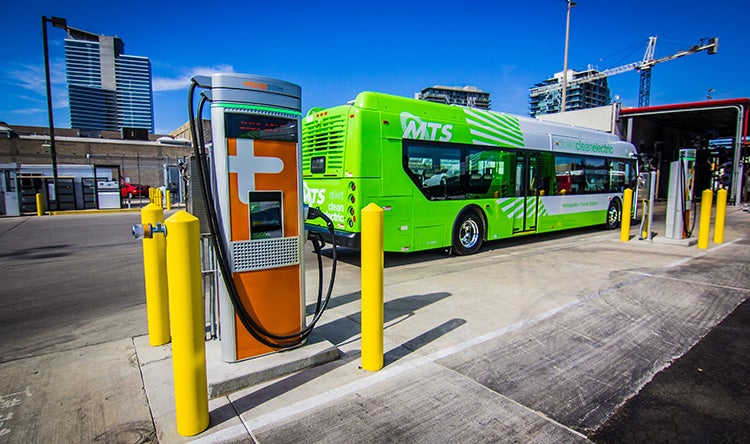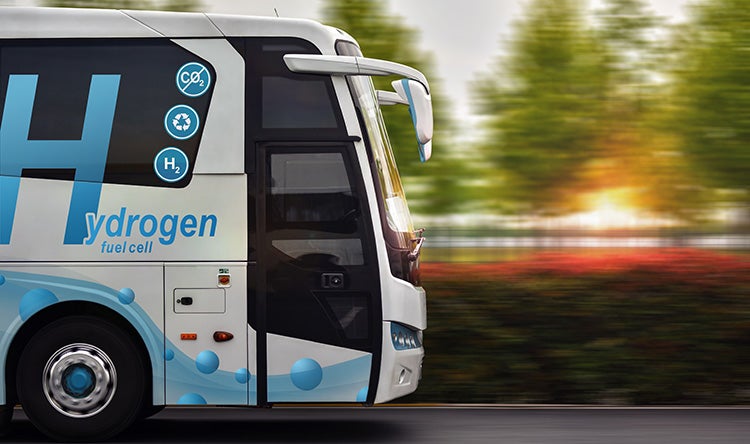
Experts Talk: Funding Strategies for Zero Emissions Fleet Conversions with Eric Rouse
Experts Talk is an interview series with technical leaders from across our transportation program.
Financial Planning Is Key to Successful Transitions by Fleet Owners
Transit agencies and fleet owners across the U.S. have embraced the possibilities and benefits of converting their vehicles to zero emission fuels. As with any new and emerging technology, there are many uncertainties and complications that must be considered, particularly in how to budget for the transition.

Eric Rouse is a financial expert and principal consultant within our transportation economics and finance practice. He specializes in the financial, operational, and institutional analysis of existing and planned transportation systems, as well as the planning and prioritization of major capital improvement programs. He has worked with transit agencies and fleet owners across the nation, including agencies in Chicago, New York, Los Angeles, Boston, Atlanta, Indianapolis and Albuquerque.
In this interview, he discusses the role of financial planning in fleet conversions, funding options, including grants and potential private-sector partnerships, as well as why it makes sense to start the process now.
Funding Strategies for Zero Emissions Fleet Conversions
Q. Why is a financial expert part of a zero emissions team, alongside transportation planners, utility engineers, operators and facility designers?
A. Because at the end of the day, you still need to know how you can pay for this conversion within the constraints of day-to-day operations and any capital needs. You need to make sure you're not taking money from other prioritized projects or projects that need to be built just to make this transition. So, you need to think about how this will fit and how this transition will be layered in.
Perhaps this is an investment you had not planned for five years ago and now you have start-up infrastructure, equipment and new types of vehicles that need to be funded. Agency staff will need to seek board or a council approval to request additional funding or the reprogramming of existing projects and budgets. Decision makers will want to know: Are there federal and state grants available or will the transition need to be funded by the local community? Will the transition pay for itself? If so, how long will it take? If not, what other benefits will be achieved to offset any potential cost increases?
Financial experts, such as myself and others at HDR, provide the services to answer these questions. We evaluate funding sources, analyze lifecycle costs, calculate return on investments, and document the monetized environmental and social benefits that will result from a transition to Zero Emission/Electrified Vehicles.

Q. How does your role differ from the financial experts already working for agencies and government bodies?
A. Part of it is understanding the responsibilities of internal financial staff members and their capacity to take on more projects, such as a transition to ZEM/EV’s. More specifically, agency staff may not have the bandwidth to get up to speed on the latest financial opportunities or transition strategies being considered around the country, including what has worked for other agencies. Our financial experts will work closely with agency staff to develop a customized strategy that is aligned with the agency’s program goals and capabilities.
We have supported agencies in the past by sharing lessons learned on projects with similar funding challenges. We have also provided research and case studies on how peer agencies have successfully implemented capital programs. These approaches typically result in a summary list of funding sources, potential grant opportunities and innovative financing strategies, including opportunities for partnering with the private sector. That list of options can then be used as a guide to develop a preferred financial strategy to support a fleet conversion implementation and roadmap.
Q. What are the grant options available for zero emission fleet conversions?
A. At the federal level, there are two main grant opportunities from the Federal Transit Administration: Bus and Bus Facility grants, and Low or No Emission Vehicle grants.
For each of these competitive grant programs, the federal government will provide a small amount of seed money to help agencies to make the first jump into the zero emissions transition and get the ball rolling. Grant awards are often between $2 million and $5 million, usually enough to buy a limited number of electric buses and the associated equipment and infrastructure required for charging. These initial steps often serve as a pilot program from which an agency’s operating team can show decision-makers the costs and benefits of a full-fleet transition.
There are also some state grant programs. The primary example right now is California, which has designated programs to reduce greenhouse gas emissions. On an annual basis, California offers competitive grant opportunities for its transit agencies and other municipal agencies to get funding for the transition to zero emissions. California is ahead of most other states in that regard.
The other primary source, which many other states are using, includes payouts from the multibillion-dollar Volkswagen settlement. Money from the company’s emissions settlement was earmarked for reducing emissions and states used that money to jumpstart some conversion projects. Based on the agreement, all states receive a share of the settlement and each state has prepared a Beneficiary Mitigation Plan that outlines the process and eligible uses for these funds.

Q. What funding options are there beyond grants? Can the private sector help pay for these conversions?
A. It depends on the project, and it depends on the agency. Federal loan programs are one option. The program that most agencies would use is called TIFIA, the Transportation Infrastructure Finance and Innovation Act. It’s a low interest loan program that can provide financing support.
Agencies can also issue debt against their annual FTA formula funds and many have used this option to accelerate large-scale capital projects.
For example, if an agency gets $5 million per year in an FTA formula grant, they could use a portion or all of the annual grant to issue debt that would be repaid over a 15 to 30 year period. The portion of the annual formula grant would depend on the agency being able to address other asset maintenance and state of good repair requirements. With regards to a potential zero emissions transition, using bonds could provide access to a large share of the upfront funding needed to make the conversion all at once instead of spreading out the transition over a long period as funding becomes available.
There also may be opportunities to partner with the private sector, especially if agencies pursuing electrification are willing to allow the public to use their charging stations as part of a lease agreement. In this arrangement, a private group would pay a transit agency to lease the charging stations, perhaps during certain time periods. Then, in turn, the leasing group could charge the general public a fee to power their personal vehicles at the station, which is owned by the agency.
Q. Why should I explore fleet conversion now? Why not wait a few years?
A. Now is the right time to start thinking about what needs to happen to make this transition. Battery technology is advancing to make electrified mobility more affordable. Coupled with agency goals to reduce carbon-based emissions has caused fleet transition plans to be more important and increasing in priority. Planning can start now, determining the location of facilities, the number of buses, routes, collaboration with utilities and all of the prep work needed for a successful plan. All of the upfront planning and design work can be done to get everything “shovel-ready” for when the funding is available.
Having a target date and plan in mind can also help prevent unnecessary expenses with existing assets. For example, if you are hoping to transition to electric buses in three years, perhaps you should try to extend the life of your existing diesel bus fleet with more maintenance, rather than replace them with new diesel vehicles according to the regular replacement schedule. Planning should be comprehensive and look at more than just the implementation stage. It’s not just about buying new equipment; it’s also about getting the most out of the existing services, facilities and assets you have while considering a conversion to zero emissions.
Our zero emissions team has developed two tools to support these planning efforts: The Zero+ route-modelling tool allows agencies to evaluate different operating and transition plan scenarios related to vehicle and charging infrastructure needs for a single route or for the full system. The EconMOVES model combines the outputs from the Zero+ tool with the agency’s existing long-range operating, capital and financial plan, to evaluate the financial implications of different transition scenarios combined with other planned capital asset management and expansion programs and operating enhancements.

Inspiration & Advice
Q. How did you become involved in the economics of transit projects and transportation funding?
A. I started my career as an operations planner for a transit agency. I quickly learned that in addition to reviewing schedules and ridership trends, the planning team coordinated with all departments within the agency, which resulted in a comprehensive introduction to the transit industry. When I transitioned to consulting, I had the opportunity to support FTA grant applications, which required thorough research into agencies’ financial and operating performance and forecasts to meet FTA requirements. From both on-the-job experiences, I’ve learned how transit agencies operate on a day-to-day basis and more importantly, the variety of approaches used to fund services and capital programs.
I’ve always had an interest in analytics and the implications of increases of service and ridership. I enjoy doing that kind of numbers analysis as well as being involved with the full totality of a project. With this type of work, you need to understand the financial aspects, but also operations and capital costs, such as future projects or asset management. The chance to be involved with the multiple disciplines required for this role really drew me into this specialty.
Q. What advice do you have for planners or financial analysts starting out in the field or for engineers working with financial consultants?
A. Don't get pigeonholed. Look for opportunities to do creative work that supports implementing projects, even when it doesn't directly connect to transportation planning or engineering.
It's just like anything else. Find a good mentor, be ambitious and be willing to learn new things on the job.
Each Experts Talk interview illuminates a different aspect of transportation infrastructure planning, design and delivery. Check back regularly to gain insights from specialized experts and thought leaders behind our award-winning, full service consulting practice.



